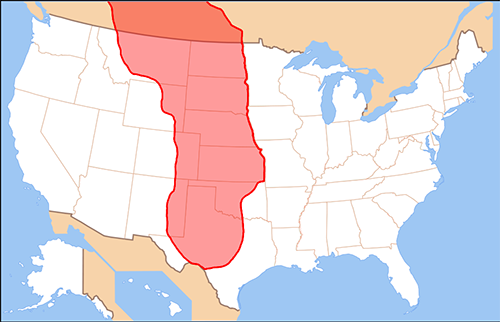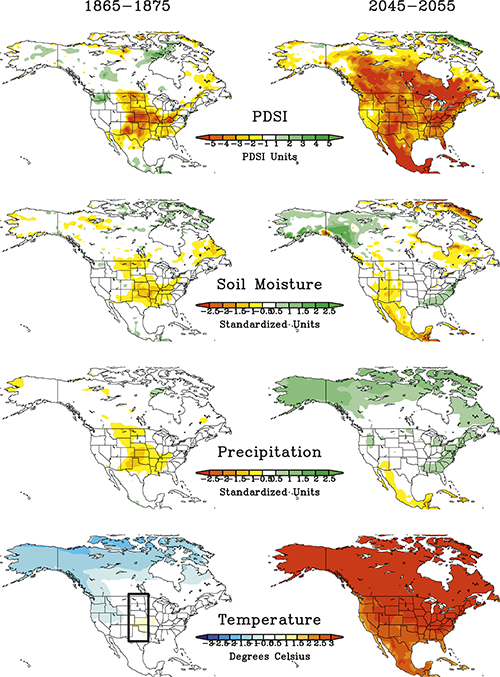Drought and America's Heartland
New NOAA study suggests Great Plains may not suffer semi-permanent Dust Bowl as climate changes

Sweeping down from Canada to the border of Mexico, the grasslands and prairie of the Great Plains provide half the world's wheat exports in addition to other crops. Weather blowing in from Canada, the Gulf of Mexico, and even the Pacific can cause large swings in temperature and precipitation in the region between seasons and years. Drought, sometimes severe – like the Dust Bowl of the 1930s – has been a recurring problem for the Great Plains over the past 150 years. With the central U.S. droughts of 2011 and 2012 fresh in people's minds, many are asking, "Is this climate change?" and wondering what the future might hold for America's heartland in a changing climate. Projections into the mid-21st century have conflicted as some studies suggest there could be more frequent droughts that could even cause a semi-permanent Dust Bowl, while others point to only minor changes in moisture over the Great Plains.

A new study, published in the Journal of Climate by NOAA Earth System Research Laboratory (ESRL) researchers, explores the reasons behind these diverging views. The good news is that the future of drought in the Great Plains is probably not as dire as some earlier studies projecting a semi-permanent Dust Bowl suggest.
The opposing outlooks arise from two different assessment approaches. The first approach uses the Palmer Drought Severity Index (PDSI). This widely used index to infer soil moisture was developed in the 1960s by Wayne Palmer of the U.S. Weather Bureau (the predecessor of the NOAA National Weather Service), and considers only temperature and rainfall information to estimate dryness. The second approach uses soil moisture predicted by sophisticated climate models. These models more completely represent the physical processes important for soil moisture, including plant life cycles and their canopies, root systems and how they extract soil moisture, and pores and cells of leaves and how those react to a warming climate—all vital components of drought.

In 2012, the United Nations Intergovernmental Panel on Climate Change (IPCC) released the Special Report on Managing the Risks of Extreme Events and Disasters to Advance Climate Change Adaptation. This report brought together experts in climate, disaster risk management, and adaptation to develop an approach for dealing with the risks of extreme events in a changing climate. Scientists evaluated existing research findings, often involving analysis of multiple climate models using different drought indices. The net assessment was one of appreciable disagreement among existing projections of what may happen in the future with Great Plains' drought.
Motivated by the report's findings, Martin Hoerling, Ph.D., a meteorologist at ESRL's Physical Sciences Laboratory, assembled a team of scientists from NOAA and the University of Colorado's Cooperative Institute for Research in Environmental Sciences to determine why the report was inconclusive. Their strategy was to repeat several analyses that were included in the IPCC assessment, but in a more controlled manner using an advanced climate model – the most up-to-date version of the Community Climate System Model (CCSM4). The team generated an analysis of Great Plains drought for the years 1850 through 2100 using the two indices – one based on Palmer's formula using the climate model's temperature and rainfall as input to infer soil moisture, and the other based on the climate model's explicit soil moisture simulation. The study was able to recreate two very different scenarios for future drought, the very situation that led to large uncertainty.
"We're not the first to approach this problem," said Hoerling, "But this is a clear side-by-side comparison that may help clarify whether or not a semi-permanent Dust Bowl is imminent for the Great Plains."
Using CCSM4 data, temperature and precipitation variables were plugged into the PDSI and compared to a CCSM4 model that also included soil moisture information. Historical computer simulations and climate projections were created from both approaches, and then examined. What Hoerling and his team found was that the PDSI works well as long as climate remains stationary – when no warming trends are involved.
"The two approaches yield comparable indications of drought in the 20th century," said Hoerling. "But the Palmer index ceases to be a reliable indicator of drought and implied agricultural stress in a warming climate of the 21st century."
When average temperature begins to rise it produces an exaggerated increase in drought severity in Palmer's formula, not only over the Great Plains, but also over the entire United States. The study finds that Palmer's drought index is erroneously sensitive to the rise in surface air temperatures, inflating the implied evaporation of moisture from soils, and completely changing the physics of the surface-moisture balance relative to the 20th century. Such a radical changeover is not confirmed when studying soil moisture from the climate models directly.
The PDSI has been widely used in climate science including drought projections. It is even considered by some as the "backbone of drought monitoring" because it is very accessible and easy to use. But this study confirms prior suggestions that it is unreliable for projections of future climate. State-of-the-art global climate models give soil moisture information that is based on numerous inputs such as plant biology, and these now produce more realistic and credible treatments of the complexity of soil moisture variability that could lead to drought.
"PDSI exaggerates future drought severity over the Great Plains because of an unrealistic sensitivity to surface warming," said Hoerling. "Drought projections based on this index for coming decades should probably be discounted."
By Barb DeLuisi, Fall 2012